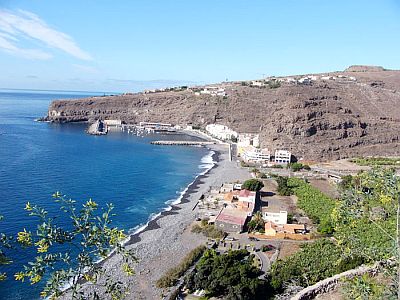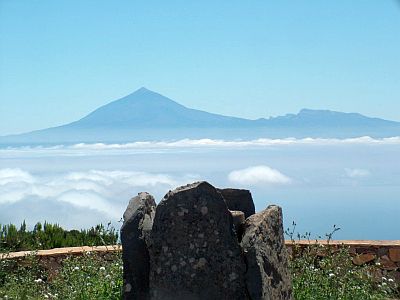In La Gomera, a small round-shaped island belonging to the Canaries, the climate is
subtropical oceanic on the coasts, that is, very mild and sunny most of the year, with very mild, spring-like winters and warm, sunny summers; there is also little rainfall, concentrated in the period from October to March.
In the interior, the climate varies instead according to altitude and slope exposure: in fact, the slopes exposed to the northeast trade winds receive a moderate amount of
rain and are green, while on the southern slopes, the rainfall is scarcer, often below 350 millimeters (13.5 inches) per year, to the point that the island appears to be divided in two, the northern part being verdant and the southern one semi-arid.
The prevailing winds, the northeast
trade winds, make the northern slope more humid, while they temper the heat along the coasts during summer. The trade winds blow more intensely in the afternoon, when they are often moderate or even quite strong.
Along the
coasts, where the largest city,
San Sebastián de la Gomera, is located, daytime temperatures are very mild in winter, around 22 °C (71.5 °F) in January and February, and warm in summer, around 27/28 °C (81/82 °F) from July to September. Here are the average temperatures in San Sebastián.
San Sebastián - Average temperatures (2017-2023) | Month | Min (°C) | Max (°C) | Mean (°C) | Min (°F) | Max (°F) | Mean (°F) |
|---|
| January | 16.8 | 21.8 | 19.3 | 62 | 71 | 66.7 |
|---|
| February | 16.8 | 21.8 | 19.3 | 62 | 71 | 66.7 |
|---|
| March | 17.4 | 22 | 19.7 | 63 | 72 | 67.5 |
|---|
| April | 17.9 | 22.6 | 20.2 | 64 | 73 | 68.4 |
|---|
| May | 18.8 | 23.1 | 21 | 66 | 74 | 69.7 |
|---|
| June | 20.6 | 25.1 | 22.8 | 69 | 77 | 73.1 |
|---|
| July | 22.2 | 26.9 | 24.5 | 72 | 80 | 76.2 |
|---|
| August | 23.2 | 28.3 | 25.8 | 74 | 83 | 78.4 |
|---|
| September | 23.1 | 27.5 | 25.3 | 74 | 82 | 77.5 |
|---|
| October | 22 | 26.8 | 24.4 | 72 | 80 | 75.9 |
|---|
| November | 19.9 | 24.4 | 22.2 | 68 | 76 | 71.9 |
|---|
| December | 17.9 | 22.7 | 20.3 | 64 | 73 | 68.5 |
|---|
| Year | 19.7 | 24.4 | 22.05 | 67.5 | 76 | 71.5 |
|---|
The temperature tends to stay around the average, however, from December to March, there can be some
cool days, with highs below 20 °C (68 °F). On the coldest days of the year, which typically occur in February, the temperature typically drops to 10/11 °C (50/52 °F) at night, while the maximum remains around 17/18 °C (63/64 °F).
On the other hand, the days of
calima, characterized by abnormal heat and light wind, when
warm air masses from Africa prevail, are relatively rare, and are more frequent in spring and summer: in practice, these are the only days when the temperature exceeds 30 °C (86 °F) and when the heat is unpleasant. The
calima is also felt on inland hills, and it's often felt even more than in the plains: this happens because warm air is lighter and tends to rise, and also because the coasts can receive a cool breeze from the sea. At the worst times, the temperature can reach 35 °C (95 °F) in spring and autumn and 40 °C (104 °F) in summer.
 Rainfall
Rainfall is very scarce, however, the pattern is Mediterranean, which means that the bulk of the rain falls between October and March, when the Canary Islands are sometimes reached by Atlantic depressions; in summer, on the contrary, it hardly ever rains. Here is the average precipitation in San Sebastián.
San Sebastián - Average precipitation| Month | Millimeters | Inches | Days |
|---|
| January | 35 | 1.4 | |
|---|
| February | 28 | 1.1 | |
|---|
| March | 32 | 1.2 | |
|---|
| April | 19 | 0.7 | |
|---|
| May | 7 | 0.3 | |
|---|
| June | 3 | 0.1 | |
|---|
| July | 1 | 0 | |
|---|
| August | 1 | 0.1 | |
|---|
| September | 5 | 0.2 | |
|---|
| October | 26 | 1 | |
|---|
| November | 43 | 1.7 | |
|---|
| December | 36 | 1.4 | |
|---|
| Year | 235 | 9.3 | |
|---|
In the
interior of the island, entirely occupied by hills and mountains, the weather gets cooler as you go up in altitude. Above 1,000 meters (3,300 ft), it can get cold in winter. In Laguna Grande, at 1,250 meters (4,100 ft), in January 1989 the temperature dropped to -3 °C (26.5 °F).
As mentioned, the north side has a cool and humid microclimate, with rains of some importance in the cold half of the year, and more frequent mists and clouds for much of the year due to the trade winds, so much so that there are several towns that are situated in a green environment. At 600/700 meters (2,000/2,300 feet), the daytime temperatures are about 16 °C (61 °F) in winter and 25 °C (77 °F) in summer.
The highest peak is
Garajonay, 1,487 meters (4,879 ft) high. The area to the north of the mountain is very green, in fact, it is covered by a thick forest of laurel trees, in addition, it's home to some endemic species, and it is a national park (called
Garajonay National Park) as well as a
World Heritage Site by UNESCO since 1986.

The amount of
sunshine in La Gomera is very good throughout the year, however, in addition to the low pressure systems that can pass over the island from October to March, cloud banks can form in summer on the Atlantic Ocean and then affect the island. On the northern coasts, and especially on the mountain slopes exposed to the north, local clouds and fogs can form. The southern coast is therefore the sunniest one.
Here are the average daily sunshine hours in San Sebastián.
San Sebastián - Sunshine hours| Month | Average | Total |
|---|
January | 4.5 | 145 | February | 5.5 | 155 | March | 6 | 190 | April | 7 | 205 | May | 8 | 245 | June | 8 | 240 | July | 7 | 220 | August | 7.5 | 240 | September | 7 | 215 | October | 6.5 | 195 | November | 5 | 150 | December | 4.5 | 140 | Year | 6.4 | 2345 |
The
sea in La Gomera is quite cold in winter, though not prohibitively, and becomes warm enough for swimming from August to October. The island is located at a low latitude, near the Tropic of Cancer, but in this part of the Atlantic, a cold current flows. The sea temperature ranges from 19 °C (66 °F) between January and April to 23 °C (73 °F) between August and October. Here are the average sea temperatures.
La Gomera - Sea temperature| Month | Celsius (°C) | Fahrenheit (°F) |
|---|
January | 19 | 66 | February | 19 | 66 | March | 19 | 66 | April | 19 | 66 | May | 20 | 68 | June | 21 | 70 | July | 22 | 72 | August | 23 | 73 | September | 23 | 73 | October | 23 | 73 | November | 22 | 72 | December | 20 | 68 | Year | 20.9 | 69.5 |
Best Time
The best time for a beach holiday in La Gomera runs from
May to mid-October. In the first period (May-June), the air temperature is a bit lower and the sea is a bit colder, but the days are slightly longer. In the Canaries, the days in summer are shorter than in Europe (while they are longer in winter), but because of the time zone adopted, the sun sets late enough anyway.
If you want to visit cities or to go on excursions to the interior, you can choose April, May, and the first half of October.
In winter, you will appreciate the mild temperatures and you can often sunbathe, although we can not exclude some days of bad weather.
What to pack in the suitcase
In winter: bring light clothes for the day, a sweater and a jacket for the evening, and possibly a raincoat or umbrella. To climb mount Garajonay, bring a down jacket, and hiking shoes.
In summer: bring summer clothes, but also a scarf for the wind, a light sweatshirt, and a light jacket for the evening and for windy afternoons. To climb mount Garajonay, hiking shoes, and a sweatshirt and a light jacket.